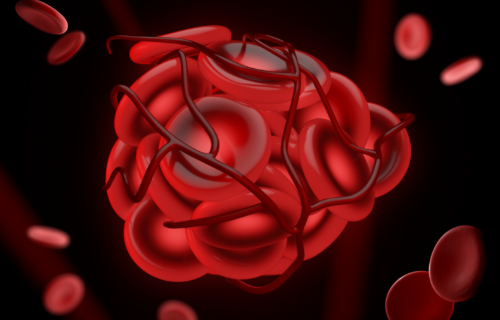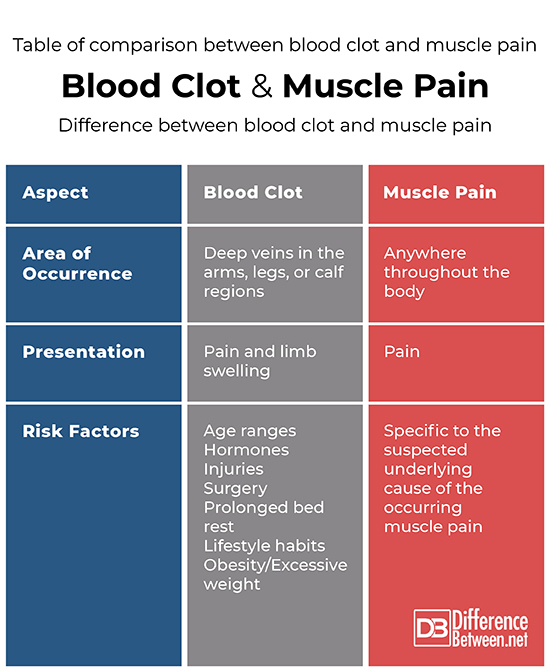Difference Between Blood Clot and Muscle Pain

Introduction
Normal muscle pain and a blood clot can be challenging to differentiate. Both can occur in the calf muscles, thigh muscles and arm muscles. Both can present with a hot muscle, cramping sensation and even a jolting feel throughout.
What makes these two easier to discern is mainly the type of pain experienced, other risk factors, a history of what lead up to the pain and, of course, diagnostic tools such as an ultrasound scan.

Certainly, difficult to determine, these conditions must be closely looked at. Follow us as we delve into the specific differences between a blood clot and general muscle pain.
Definition
Blood Clot
Blood clots can occur anywhere in the circulatory system. More specifically, in the body’s vascular system. The most common type of blood clot that causes muscle pain too is a deep vein thrombosis (DVT). This occurs most often in the lower extremities such as the calf or the thighs. A deep vein thrombosis happens when coagulated (or clotted) blood gathers in a deep venous area that works to return blood to the heart.
Muscle pain is also commonly referred to as myalgia. Myalgia, or muscle pain, specifically describes aches and pain that can come from joints, ligaments or tendons, muscle fascia, soft tissue which connects muscle, bones, and it may even originate from certain organs. Anything from tension to overuse to drug overdoses can be behind muscle pain.
Presentation
In a classic case of a blood clot, or deep venous thrombosis (DVT), there is a presence of pain and limb swelling. However various symptoms may be present or absent in various patients. Certain patients experience symptoms on both sides (or both limbs), on one side, and the symptoms can range from mild to severe. Generally speaking, leg pain occurs in about half of patients suffering from a blood clot, but this can vary.
Pain can occur when moving the foot up and is referred to as “Homans sign”. A feeling of tenderness is seen in 75% of patients and is usually specific to the calf muscles or along the middle of the thigh. If pain and/or tenderness is felt in areas other than these then it is not consistent with venous thrombosis and usually indicates another condition and diagnosis to be made.
When it comes to muscle pain, symptoms can occur anywhere throughout the body. This pain can be localized to an area, present as a sensation of deep pain, be a dull or sharp pain, can occur while resting or with movement, it can last for short periods of time or be constant, and the pain can also be widespread.
Clinical Diagnosis
To diagnose a blood clot, a number of medical tests and technologies can be used. The most commonly used device is a duplex ultrasonography test. This test is a type of imaging technology that uses sound waves to get a look at blood flow inside the veins. The specific ultrasound is useful in detecting blockages in deep veins. Additionally, a D-Dimer blood test can be done and indicates how much substance was released when a blood clot breaks up in the blood. A Wells Score (a type of scoring system) is also completed to determine the likelihood of occurrence of a deep vein thrombosis.
Muscle pain is more complex to diagnose. For this is successfully be done, a number of tests and questions take place. Firstly, a medical history is usually taken from a patient to get all the background information on previously occurring injuries, illnesses and other conditions. Thereafter, a physical examination usually takes place. This evaluates the painful area and looks at the state the muscle is in (the tone, strength and level of stiffness). Medical tests can also be done. These include blood test which show levels of muscle enzymes indicating muscle inflammation and damage. Finally, imaging tests are a useful tool to use. X-rays and MRI scans can be used to diagnose a muscle condition or to rule out suspected causes of specific muscle pain.
Risk Factors
The biggest risk factors for a blood clot potentially include:
- Age ranges
- Hormonal states (such as pregnancy or being on birth control)
- Injuries, surgery, or long-term bed rest (such as a prolonged hospital stay)
- Being overweight or in a state of obesity
- Lifestyle habits such as smoking
Different types of muscle pain are synonymous with different types of conditions. Therefore, there are not general risk factors for muscle pain. For example, muscle pain can come from over-exercising but also be caused by an underlying medical condition.
Once the suspected cause of muscle pain has been determined, then risk factors for the potential diagnosis can be better explored.
Table of comparison between blood clot and muscle pain

Summary
It is challenging to direct compare the occurrence of a blood clot and the occurrence of muscle pain, as they are very different concepts which happen to share a single common symptom, namely myalgia (muscle pain). However, it is vitally important to be able to distinguish between simple generalized muscle pain and the likelihood of a blood clot. If you suspect the presence of a DVT, it is important to seek medical advice promptly to avoid the development of severe complications.
FAQ
How can you tell the difference between a blood clot and muscle pain?
Blood clot pain is usually located in the calf muscle or along the inside of the thigh, whereas muscle pain can occur almost anywhere else. Pain from a blood clot is also usually associated with swelling of the affected limb and mostly only occurs on one specific side.
Does a blood clot feel like muscle pain?
A blood clot can potentially feel just like muscle pain. This is what makes it so important to consider the risk factors present for the development of a blood clot and other symptoms that might lead you towards the diagnosis of a blood clot.
How does blood clot pain feel?
It might feel like throbbing or cramping pain in one leg (rarely both legs), rather than a stabbing type of pain.
Is it a blood clot or just leg pain?
To determine the likeliness of a blood clot, your doctor will use what is called the Wells criteria to make a proper diagnosis.
- Difference Between a Cochlear Implant and Normal Hearing - October 4, 2022
- Difference Between Obstructive and Restrictive Spirometry - September 11, 2022
- The Difference Between White Box and Black Box Testing - September 11, 2022
Search DifferenceBetween.net :
Leave a Response
References :
[0]Haeger, K. “Problems of acute deep venous thrombosis. The interpretations of signs and symptoms”. Angiology, vol. 20, no. 4, 1969, pp: 219-223.
[1]McLachlin, J., Richards, T. & Paterson, J. “An evaluation of clinical signs in the diagnosis of venous thrombosis”. The Archives of Surgery, vol. 85, 1962, pp: 738-744.
[2]National Health Service. “DVT (deep vein thrombosis)”. https://www.nhs.uk/conditions/deep-vein-thrombosis-dvt/
[3]VeryWellHealth. “An Overview of Myalgia”. 2022. https://www.verywellhealth.com/myalgia-overview-4584594
